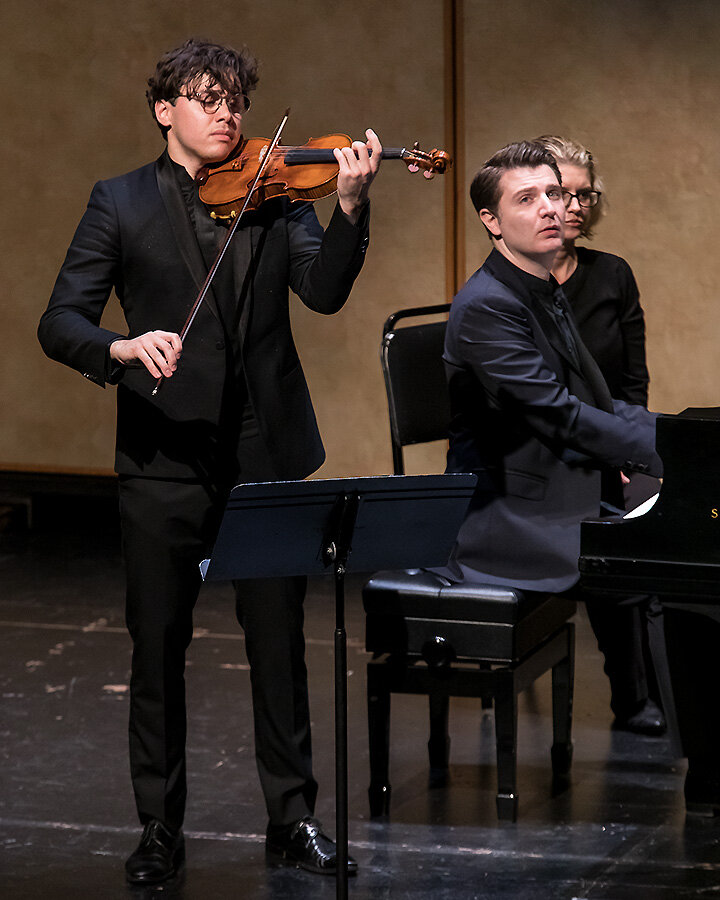Lobero Theatre Chamber Music Series 2020-2021 — read the reviews
++ Here is my review for Santa Barbara’s arts weekly VOICE Magazine of the second set of recitals in the Lobero Theatre Chamber Music Series in Santa Barbara on February 8, 2020:
Visit Artistic and Music Director/violist Heiichiro Ohyama’s website
Visit Musical Advisor/violinist Benjamin Beilman’s website
Visit pianist Louis Schwizgebel’s website
Visit violinist Ida Kavafian’s webpage
Visit Clive Greensmith’s website
Shimmering Virtuosity
The Lobero Theatre’s new Chamber Music Project under Artistic and Music Director Heiichiro Ohyama’s supervision, with performing colleague violinist Benjamin Beilman Musical Advisor, returned to Santa Barbara’s Lobero Theatre on February 8th and 9th for two completely different yet similarly messaged programs of music by Beethoven, Prokofiev/Kodály and Brahms. A fabulous series debut on January 4 by pianist Alessio Bax and violinist Beilman set a high bar and augured well for the new Chamber Music Project. The recital I saw on February 8th confirmed earlier predictions.
A larger house at the February 8th recital – an excellent sign - was unusually focused and still throughout the evening for a program of works by Beethoven, Prokofiev and Brahms. Mesmerizing, leisurely and silken describes inadequately, the ensemble temperament and timbre of this powerful gathering of Heiichiro Ohyama’s musical friends. A subtly powerful concordance of experience and empathy between each player bespoke artistic unanimity – a rare pleasure to see and hear. Pianist Louis Schwizgebel; violinists Ida Kavafian and Benjamin Beilman; violist Heiichiro Ohyama and cellist Clive Greensmith gave listeners an evening of sonic elegance.
Beethoven’s Quartet for Piano and Strings in E-flat Major, Op. 16 (1797) performed by Schwizgebel, Kavafian, Ohyama and Greensmith opened the program at a dynamic level so soft and fragile in the opening bars of the first movement Grave: Allegro ma non troppo one fell completely under its spell, the audience as quiet and concentrated as the music making itself. Several interpretive wonders ensued, including whispered unison passage work that shimmered with perfect intonation and balance; terraced modulations from one characterful instrumental narrative to another that spoke to Beethoven’s kinky harmonic eccentricities even in his 20s and a model of performance practice that illustrated not just Beethoven’s virtuoso piano writing, but also his debt to Mozart and Haydn. The second movement Andante cantabile with its panoply of fabulously busy piano riffs, yummy viola inner voicing and luscious cello melodies served as amiable preamble to the last movement Rondo: Allegro ma non troppo which topped off the performance at a nice pace that nevertheless allowed plenty of opportunity to relish its several meaty and precocious developmental and modulatory passages.
Prokofiev’s Sonata for Two Violins in C Major, Op. 56 (1932) performed as if from a long-lost mindscape by consummate master Ida Kavafian and her former student and long since professional colleague Benjamin Beilman, was revelatory at several levels, most of them intuitive. Composed while Prokofiev was living in Paris exile from the Russian Revolution and its after-horrors, the work is haunting, particularly as performed by these two powerful intellectuals. By 1932 fascism was on the rise, Stalin was disappearing his enemies by the millions and Germany’s new Enabling Act (1933) would give Hitler unlimited power to do the same. From its sobering opening bars, the Andante cantabile speaks to profound resignation. Kavafian and Beilman bonded like survivors and provided the audience a level of perfection in musical imagery that matched timbre and technique to conscious and subliminal empathy; a stunning and deeply moving performance.
The second movement Allegro addresses with troubling and often explosive frenzy the helplessness and despair of that time, still reeling from worldwide financial depression, thus vulnerable to totalitarianism. With stunning virtuosity, the duo crushed it; flurries of musical rage assuaged somewhat by calms fraught with tense foreboding were communicated to the audience to chilling effect. The muted third movement Commodo (quasi allegretto), it’s bittersweet lullaby one of Prokofiev’s most touchingly prescient tunes, captured in the duo’s interpretation both sentimentality and calamity, touching our hearts in whispers. The last movement Allegro con moto gave some relief for its irresistible vigor. It takes true virtuosity to successfully navigate Prokofiev’s seldom performed Opus 56, a technical and intellectual Rubik’s Cube. Kavafian and Beilman honored themselves and enriched us all with their performance.
Pianist Schwizgebel, violinist Beilman, violist Ohyama and cellist Greensmith returned to the stage after intermission for a deliciously cordial performance of Brahms’ Quartet for Piano and Strings No. 1 in G minor, Op. 25 (1861). The nineteenth century presented itself casually, as might be expected from a time of gas light and horse-drawn carriage. The result, a performance of its four movements that was leisurely, the charm of Brahms’ inner voicing transparent throughout. Highlights: gorgeous dialogue between violist Ohyama and violinist Beilman in the Andante; cellist Greensmith’s opulent timbre throughout, likewise Ohyama; the heroic grandeur of the interpretation in general and the irrepressible energy of the Rondo alla Zingarese: Presto with its Hungarian folk tunes and many compositional zigs and zags, including a lovely solo piano bit, an interlude for string trio sans piano and a pulse-pumping finale.
Daniel Kepl | Performing Arts Review
++ Here is my review for Santa Barbara’s arts weekly VOICE Magazine of the debut of the Lobero Theatre Chamber Music Series in Santa Barbara on January 4, 2020:
Visit Benjamin Beilman’s website
Visit Alessio Bax’s website
Chamber Orchestra to Chamber Music Project: a phoenix rises
Violist /conductor Heiichiro Ohyama thrilled Santa Barbara audiences for nearly 40 seasons as Music Director of the Santa Barbara Chamber Orchestra. His appearances as a performing artist (viola) during the orchestra’s chamber music events were particularly magical, inspired by his virtuosity as a soloist and his deep understanding of the repertoire. Maintaining a professional ensemble of 30 or more musicians proved financially difficult and ultimately the Chamber Orchestra board decided to close its books and cede remaining assets and the future to the Lobero Theatre Foundation.
Working with maestro Ohyama for the past couple of years as the newly appointed Artistic and Music Director with violinist Benjamin Beilman functioning as Musical Advisor, the Lobero Theatre Chamber Music Project made its debut last Saturday (January 4, 2020) with a stunning program presented by two world class musicians hand-picked by Ohyama at the venerable venue that served for so many decades as the Chamber Orchestra’s home. What goes around, comes around.
Thanks to Ohyama, who brought him here regularly as a concerto soloist with the Chamber Orchestra, Santa Barbara audiences have had ample opportunity to savor and cherish the delicate musicality and peerless style of pianist Alessio Bax. Violinist Benjamin Beilman, the new Artistic Advisor to the Lobero Theatre Chamber Music Project is the fresh face in this rising from ashes metaphor. Judging from his fascinating interpretations and often jaw-dropping virtuosity performing sonatas by Bach, Busoni and Grieg last Saturday, the calculus for success with this new chamber music series in Santa Barbara’s busy classical music datebook is strong.
The overall arc of Saturday’s program, literally its dynamic range through the course of the evening’s three sonatas, might be described as something akin to a tsunami crescendo, from the whispered opening bars of the Bach sonata to the knuckle-whitening final moments of the Grieg sonata which closed the program. Beilman’s violin whispered in the Bach - nearly inaudible (stunning); his fortissimos reached the edge of harsh (be still my heart!) and were cheek to jowl and brain to brain with Allesio Bax’s enthusiastic collaborations at the keyboard. Beilman’s heady harmonic stew in deciding upon this particular set of works for his program - C minor (Bach), E minor (Busoni), C minor (Grieg) – posed the question, why? Bottom line, the sonic ambiance of these tonal universes resonated, not just at the surface but deep in the soul.
Just 30 and already an international sensation, American violinist Benjamin Beilman is an artist utterly without affectation. Every movement of his body, each marvelous to watch proof of his remarkable bow arm – a kaleidoscope of breathtaking coloration, dynamic subtlety and bar line busting phrasing – spoke volumes about his thoughtfully intuitive approach to both the instrument and his artistic integrity. As revelatory for completely different reasons as violinist Pamela Frank’s recent performance here, Beilman’s approach to Bach’s Sonata for Violin and Keyboard No. 4 in C Minor, BWV 1017 (circa 1720) was deeply reverent without drama, romantic to a fault without breaking any performance practice manners and above all easy, gentle and warm.
The third movement Adagio was particularly lovely, Beilman exploring the composer’s unusual harmonic eccentricities without unduly stirring otherwise still waters. For the last movement Allegro, Beilman and Bax were delightfully catty voice leading collaborators, but Beilman’s performance in particular hinted at aspects of the violinist’s command of force – his top dynamic - and the uses he would make of this power in the remaining two works on the program.
Ferruccio Busoni (1866-1924) lived in the US from 1894 to 1914 and again from 1920 to his death. His name rings bells with some music lovers for his famous piano transcriptions of other composers’ compositions, including iconic realizations for keyboard of Bach’s organ works. It’s not often that Busoni’s own portfolio is brought before the public; kudos to Beilman and Bax for programming this masterpiece. The Sonata No. 2 in E minor for Violin and Piano, Op. 36a (1898) is an extraordinary work that deserves to be an important part of the American consciousness and repertoire.
Intensely romantic and moody, one wonders if Busoni, a recent immigrant to America, might have been impacted by the Spanish-American War, which ceded The Philippines and Cuba to the US in 1898. Beilman gave the work its full and worthy breadth and measure, from whispered supplications to hugely heroic statements, often intoned quite intentionally from the instrument’s abrasive sound spectrum. The last section of the one-movement sonata, its exquisite chorale tune and variations allowed Beilman opportunity to unleash a firework or two of his own, but ultimately, sublimely, this amazing and neglected sonata settled down, it’s quiet ending a brilliant testimony to restraint.
Edvard Grieg’s Sonata No. 3 in C minor for Violin and Piano, Op. 45 (1886) rounded out the program and allowed both artists freedom to display their deep understanding of the emotional sinews of the work as well as its huge sonic capabilities. A Caprice of Kreisler as champagne encore and the new series closed in cascades of applause.
Daniel Kepl | Performing Arts Review

Recital photos by David Bazemore


Artistic & Music Director/violist Heiichiro Ohyama

Music Advisor/violinist Benjamin Beilman


Violinist Ani Kavafian


Cellist Clive Greensmith

Pianist Louis Schwizgebel
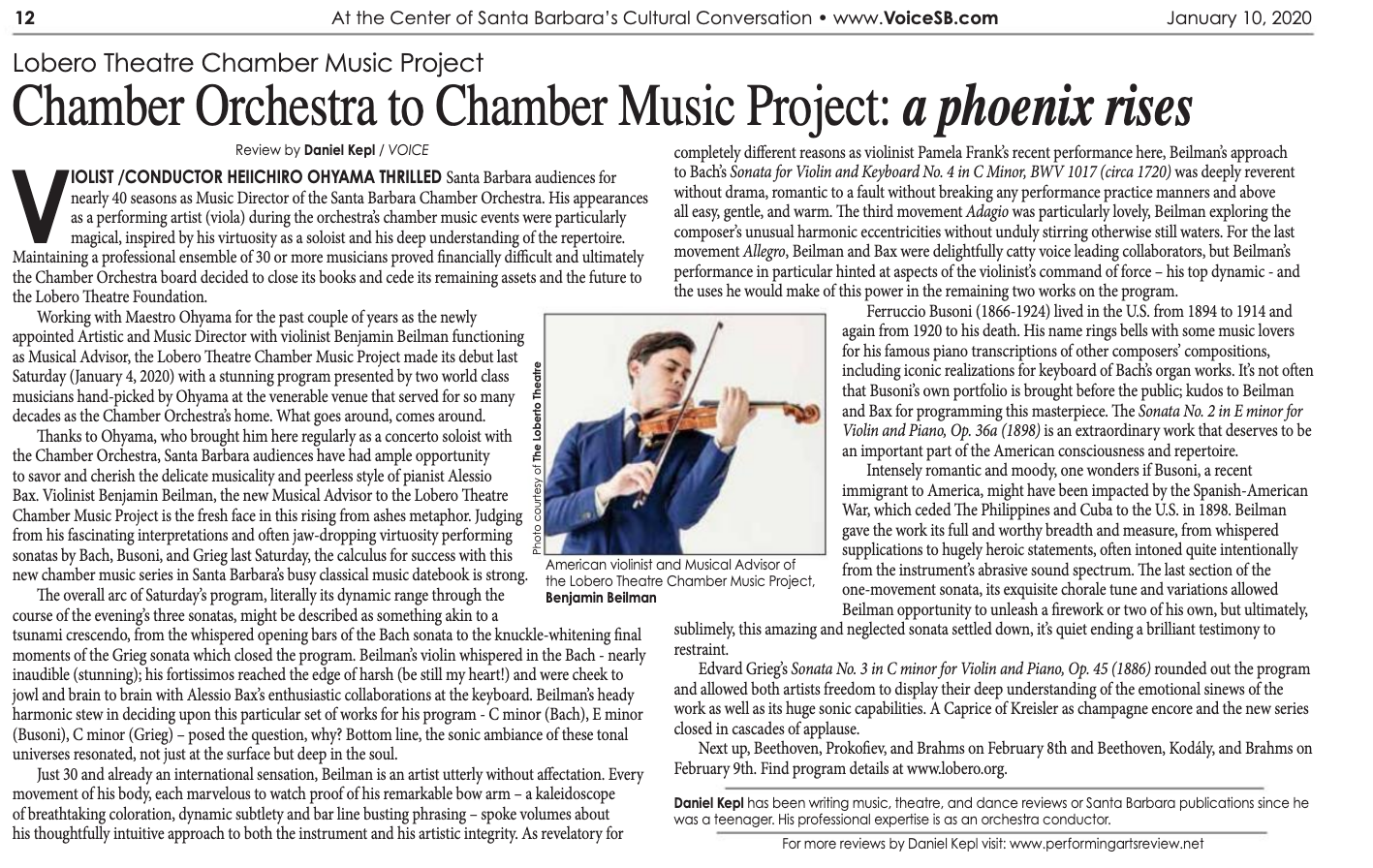
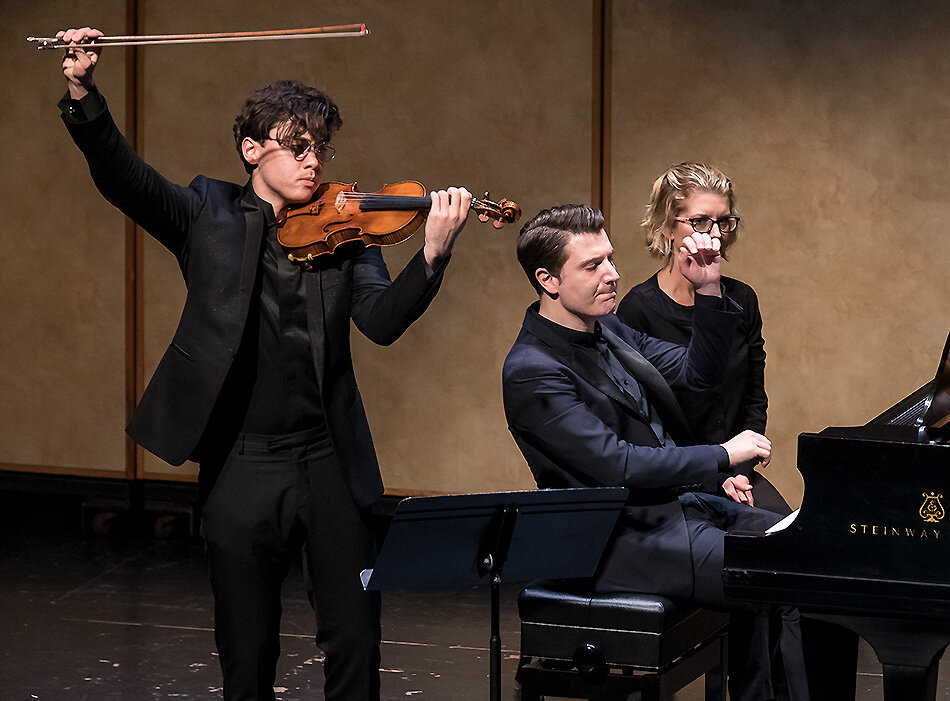
Action photography from the Lobero Theatre recital by David Bazemore
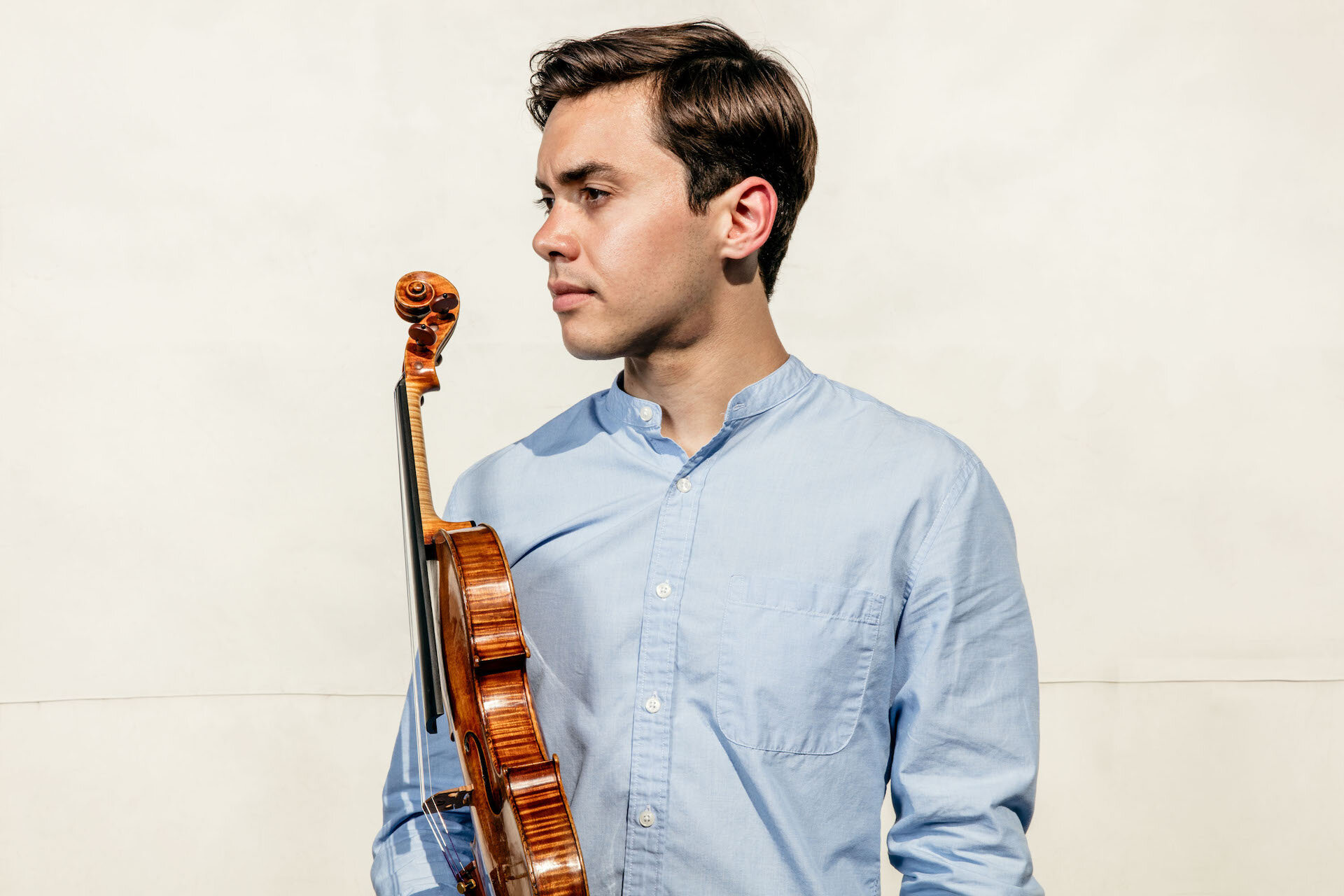
Violinist Benjamin Beilman
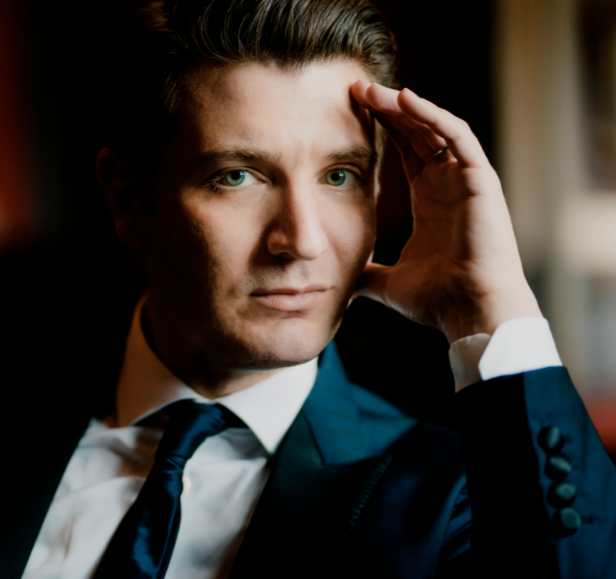
Pianist Alessio Bax
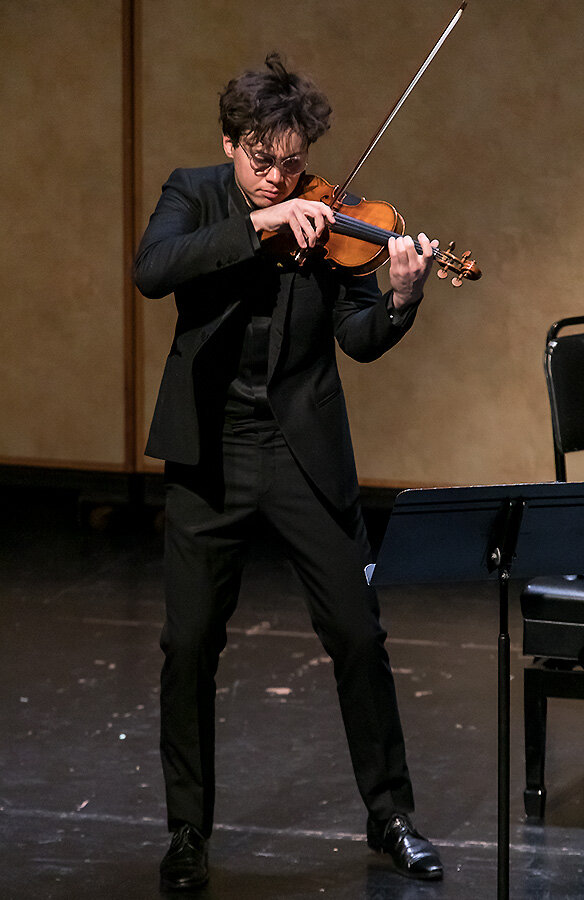
Action photography from the Lobero Theatre recital by David Bazemore
